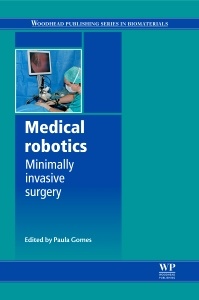Description
Medical Robotics
Minimally Invasive Surgery
Woodhead Publishing Series in Biomaterials Series
Language: English
Subjects for Medical Robotics:
326 p. · 15.5x23.2 cm · Hardback
Description
/li>Contents
/li>Biography
/li>Comment
/li>
Beginning with an introduction to robot-assisted minimally invasive surgery (MIS), the core technologies of the field are discussed, including localization and tracking technologies for medical robotics. Key applications of robotics in laparoscopy, neurology, cardiovascular interventions, urology and orthopaedics are considered, as well as applications for ear, nose and throat (ENT) surgery, vitreoretinal surgery and natural orifice transluminal endoscopic surgery (NOTES). Microscale mobile robots for the circulatory system and mesoscale robots for the gastrointestinal tract are investigated, as is MRI-based navigation for in vivo magnetic microrobots. Finally, the book concludes with a discussion of ethical issues related to the use of robotics in surgery.
With its distinguished editor and international team of expert contributors, Medical robotics: Minimally invasive surgery is a comprehensive guide for all those working in the research, design, development and application of medical robotics for surgery. It also provides an authoritative introduction for academics and medical practitioners working in this field.
Contributor contact details
Dedication
Woodhead Publishing Series in Biomaterials
Introduction
Chapter 1: Introduction to robot-assisted minimally invasive surgery (MIS)
Abstract:
1.1 Introduction
1.2 Minimally invasive surgery and robotic integration
1.3 Definitions and development of surgical robotic systems
1.4 Perceptual docking for synergistic control
1.5 Conclusions and future trends
Chapter 2: Localization and tracking technologies for medical robotics
Abstract:
2.1 Introduction
2.2 Requirements for position sensors
2.3 Dynamic referencing
2.4 Types of position sensors
2.5 Future trends
Conclusion
Chapter 3: Robotics for neurosurgery
Abstract:
3.1 Introduction to neurosurgical progression
3.2 The evolution of neurosurgical robots
3.3 Maintaining operator control
3.4 Human–machine interface (HMI)
3.5 Future trends: informatic surgery
3.6 Conclusion
3.7 Acknowledgments
Chapter 4: Robotic systems for cardiovascular interventions
Abstract:
4.1 Introduction
4.2 Heart conditions and the evolving role of cardiac surgeons and cardiologists
4.3 Surgical robot requirements and availability for cardiovascular interventions
4.4 Proposed novel robots for cardiovascular interventions
4.5 Future trends
4.6 Sources of further information and advice
Chapter 5: Robotics in orthopaedic surgery
Abstract:
5.1 Introduction
5.2 Existing orthopaedic robotic systems
5.3 Evaluation of impact of orthopaedic surgical robots
5.4 Conclusion
Chapter 6: Robotic-assisted knee replacement surgery
Abstract:
6.1 Introduction
6.2 Apex robotic technology (ART)
6.3 Clinical experience
6.4 Conclusions and future trends
6.5 Acknowledgments
Chapter 7: Robotics in ear, nose and throat (ENT) surgery
Abstract:
7.1 Introduction
7.2 Telemanipulators in ENT
7.3 Image-guided interventions
7.4 Computer numerical control (CNC)
7.5 Conclusions
Chapter 8: Robot-assisted vitreoretinal surgery
Abstract:
8.1 Introduction
8.2 Requirements for vitreoretinal surgery
8.3 Master console
8.4 Slave robot
8.5 Results
8.6 Conclusions and future trends
8.7 Acknowledgments
Chapter 9: Robotics for minimally invasive surgery (MIS) and natural orifice transluminal endoscopic surgery (NOTES)
Abstract:
9.1 Introduction
9.2 Minimally invasive surgery (MIS)
9.3 Natural orifice transluminal endoscopic surgery (NOTES)
9.4 Future trends and conclusions
Chapter 10: Mesoscale mobile robots for gastrointestinal minimally invasive surgery (MIS)
Abstract:
10.1 Introduction
10.2 Commercial gastrointestinal wireless capsule endoscopes
10.3 Robotic capsule modules
10.4 Future trends in mobile surgical devices
10.5 Conclusion
Chapter 11: Real-time software platform using MRI for in vivo navigation of magnetic microrobots
Abstract:
11.1 Introduction
11.2 Magnetic resonance imaging (MRI) navigation
11.3 Microrobot navigation
11.4 Conclusions and future trends
11.5 Sources of further information and advice
Chapter 12: Robotic surgery and ethical challenges
Abstract:
12.1 Introduction
12.2 Types of robotic surgery
12.3 The patient experience of robotic surgery
12.4 The marketing of robotic surgery
12.5 Comparing robotic surgery with other types of surgery
12.6 The need for training
12.7 Costs versus benefits
12.8 Ethical issues relating to remotely operated surgery
12.9 The automated hospital
12.10 Conclusions
Index
- Provides authoritative coverage of the core principles, applications and future potential of medical robotics
- Introduces robot-assisted minimally invasive surgery (MIS), including the core technologies of the field and localization and tracking technologies for medical robotics
- Considers key applications of robotics in laparoscopy, neurology, cardiovascular interventions, urology and orthopaedics



